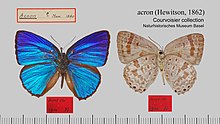| Arhopala acron | |
|---|---|

| |
| From the Courvoisier Collection, Basel, Switzerland | |
|
Scientific classification
| |
| Domain: | Eukaryota |
| Kingdom: | Animalia |
| Phylum: | Arthropoda |
| Class: | Insecta |
| Order: | Lepidoptera |
| Family: | Lycaenidae |
| Genus: | Arhopala |
| Species: | A. acron
|
| Binomial name | |
| Arhopala acron | |
| Synonyms | |
| |
Arhopala acron is a butterfly in the family Lycaenidae. It was described by William Chapman Hewitson in 1862. It is found in the Australasian realm, where it has been recorded from Bachan and Halmahera. [2]
The male has a Morpho-blue upper surface, the hindmarginal part of the forewing and the hindwing are of a glistening silvery blue, the costal part of the forewing is much darker; the under surface, however, is not whitish, but dark brown with white-edged bands and spots, somewhat similar to the agelastus-group [3]
References
- ^ Hewitson, 1862 Specimen of a Catalogue of Lycaenidae in the British Museum: [4],[1],2-15, pl. I-VIII, [1-8] (links to Ill. diurn. Lep. Lyc.)
- ^ D'Abrera, B. 1977. Butterflies of the Australian Region, edn 2. 415 pp. Lansdowne, Melbourne.
-
^
Adalbert Seitz in Seitz , A. Band 9: Abt. 2, Die exotischen Großschmetterlinge, Die indo-australischen Tagfalter, 1927, 1197 Seiten 177 Tafeln
 This article incorporates text from this source, which is in the
public domain.
This article incorporates text from this source, which is in the
public domain.
External links
- Arhopala Boisduval, 1832 at Markku Savela's Lepidoptera and Some Other Life Forms. Retrieved June 3, 2017.
| Arhopala acron | |
|---|---|

| |
| From the Courvoisier Collection, Basel, Switzerland | |
|
Scientific classification
| |
| Domain: | Eukaryota |
| Kingdom: | Animalia |
| Phylum: | Arthropoda |
| Class: | Insecta |
| Order: | Lepidoptera |
| Family: | Lycaenidae |
| Genus: | Arhopala |
| Species: | A. acron
|
| Binomial name | |
| Arhopala acron | |
| Synonyms | |
| |
Arhopala acron is a butterfly in the family Lycaenidae. It was described by William Chapman Hewitson in 1862. It is found in the Australasian realm, where it has been recorded from Bachan and Halmahera. [2]
The male has a Morpho-blue upper surface, the hindmarginal part of the forewing and the hindwing are of a glistening silvery blue, the costal part of the forewing is much darker; the under surface, however, is not whitish, but dark brown with white-edged bands and spots, somewhat similar to the agelastus-group [3]
References
- ^ Hewitson, 1862 Specimen of a Catalogue of Lycaenidae in the British Museum: [4],[1],2-15, pl. I-VIII, [1-8] (links to Ill. diurn. Lep. Lyc.)
- ^ D'Abrera, B. 1977. Butterflies of the Australian Region, edn 2. 415 pp. Lansdowne, Melbourne.
-
^
Adalbert Seitz in Seitz , A. Band 9: Abt. 2, Die exotischen Großschmetterlinge, Die indo-australischen Tagfalter, 1927, 1197 Seiten 177 Tafeln
 This article incorporates text from this source, which is in the
public domain.
This article incorporates text from this source, which is in the
public domain.
External links
- Arhopala Boisduval, 1832 at Markku Savela's Lepidoptera and Some Other Life Forms. Retrieved June 3, 2017.